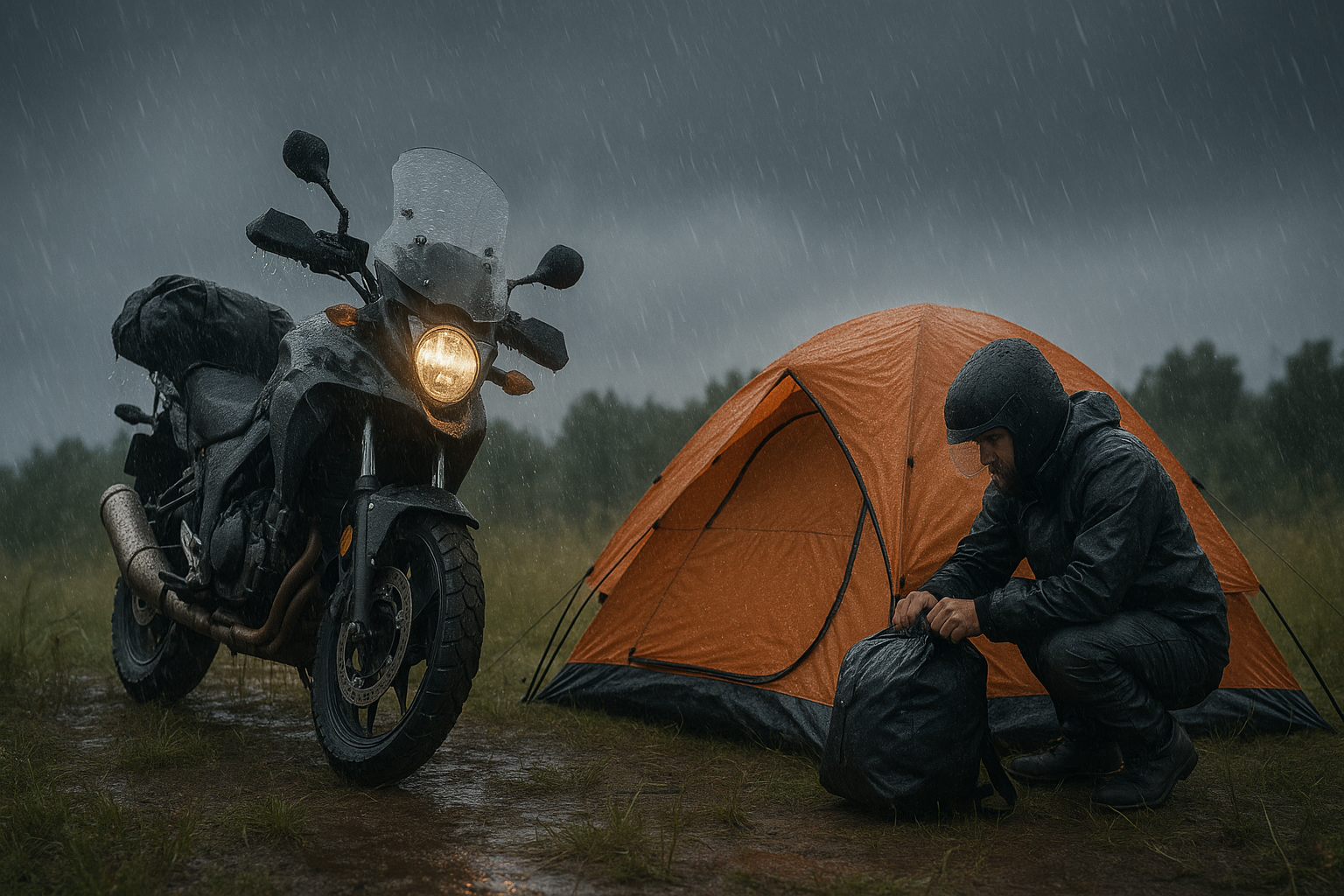You’re riding a remote trail when dark clouds roll in, faster than you expected. Within minutes, the rain slams down, soaking everything—your sleeping bag, your clothes, and even your cooking gear. Sudden storms are more than inconvenient—they can turn a motorcycle camping trip into a survival challenge. But you don’t have to let a drenching downpour ruin your night. With these unconventional, field-tested waterproofing techniques, you’ll keep your gear dry, your camp manageable, and your ride rolling forward.
Emergency Rain Shield: Improvise Fast
When the rain hits unexpectedly and you’re caught unprepared:
- Use your bike’s rain cover, spare tarp, or even a space blanket as an instant shelter for your gear.
- Drape the cover over handlebars, saddlebags, and panniers to redirect water flow away from gear.
- Anchor with bungee cords, spare straps, or weighted gear to keep the cover secure in the wind.
Pro Tip: If you don’t have a cover, a large trash bag can buy you time until you can repack.
Double-Layer Packing: The Dry Within the Wet
Even if your gear gets wet on the outside, the inside can stay safe:
- Use dry bags or vacuum-sealed bags inside panniers or backpacks.
- Double-bag electronics and critical items—inner waterproof bag inside a larger dry bag.
- Wrap sleeping bags and clothes in garbage bags or contractor bags, then seal them tightly.
Pro Tip: Use color-coded bags for quick identification in low-light or storm conditions.
DIY Waterproofing with Wax or Silicone
You can enhance your gear’s water resistance before or during your trip:
- Rub wax (like beeswax or paraffin) into fabric seams and surfaces of canvas bags or soft gear.
- Spray silicone-based waterproofer on tents, jackets, and gear covers for a quick protective layer.
- Focus on zippers and seam lines, which are often the first points of failure in heavy rain.
The “Upside Down” Dry Pack Hack
If your pack or pannier is already wet on the outside:
- Invert the gear bag, so the wet opening is at the bottom, not the top.
- Pack dry items inside in sealed bags, and gravity will keep additional water from entering.
- Hang or wedge the pack upside down in a sheltered area or beneath your makeshift cover.
Create a Natural Rain Shield
- Find natural cover like dense tree canopies, rock overhangs, or large bushes to shield your gear.
- Use branches and leafy boughs to build a quick lean-to over your camp or bike.
- Supplement with a poncho or rain fly for extra coverage.
Pro Tip: Choose a slightly elevated, sloped spot so water runs away from your gear, not towards it.
Field Repair: Seal Rips and Leaks Fast
If your gear gets torn or compromised in a storm:
- Use duct tape or Tenacious Tape to seal holes or seams in bags, tents, or jackets.
- Carry a mini sewing kit with heavy-duty thread to reinforce critical stress points.
- Apply a dab of waterproof glue (like Aquaseal) over the repair for a water-tight seal.
Insulation Against Wet Ground
- Lay down an emergency blanket or a section of closed-cell foam under your sleeping bag or tent floor.
- Use a plastic groundsheet, painter’s tarp, or even a garbage bag to create a moisture barrier.
- Elevate sleeping gear on rocks or logs to avoid direct contact with waterlogged ground.
Quick-Dry Packing Strategy
When you have no choice but to pack wet gear:
- Roll wet items in a dry towel or spare clothing to absorb excess moisture before packing.
- Pack wet gear in mesh bags or netting, which allows for airflow and reduces mildew.
- Designate one pannier or bag as the “wet bag” to isolate soaked gear from dry essentials.
Multi-Layer Waterproofing for Critical Gear
- Layer gear with a combination of dry bags, compression sacks, and waterproof liners.
- Use pack liners (like contractor bags or commercial liners) inside backpacks for an extra waterproof layer.
- Seal seams with waterproof tape or glue before the trip to preempt leaks.
Leverage Body Heat for Drying
When the storm passes but you’re left with damp gear:
- Tuck damp clothes inside your jacket (away from your skin) while riding to use your body heat for gentle drying.
- Hang items near your body while sleeping to leverage residual warmth.
- Spread items over rocks or bushes as soon as sun returns, ensuring airflow to maximize drying speed.
Field-Tested Waterproof Gear to Carry
While improvisation is crucial, certain gear makes a huge difference:
- Sea to Summit Ultra-Sil Dry Sacks: Ultralight, waterproof, and perfect for critical gear.
- Tyvek Ground Sheets: Durable, waterproof, and lightweight for under tents or gear.
- Nikwax or Gear Aid Waterproofing Sprays: Reinforce your equipment’s water resistance.
Conclusion: Stay Dry, Stay Rolling
Sudden storms don’t have to end your motorcycle camping adventure. By mastering these off-the-cuff waterproofing techniques, you’ll protect your gear from rain, puddles, and splashes. Whether it’s a simple trash bag shield, a natural lean-to, or a multi-layer dry pack, you’ll be prepared to weather any downpour—and keep riding with confidence.

